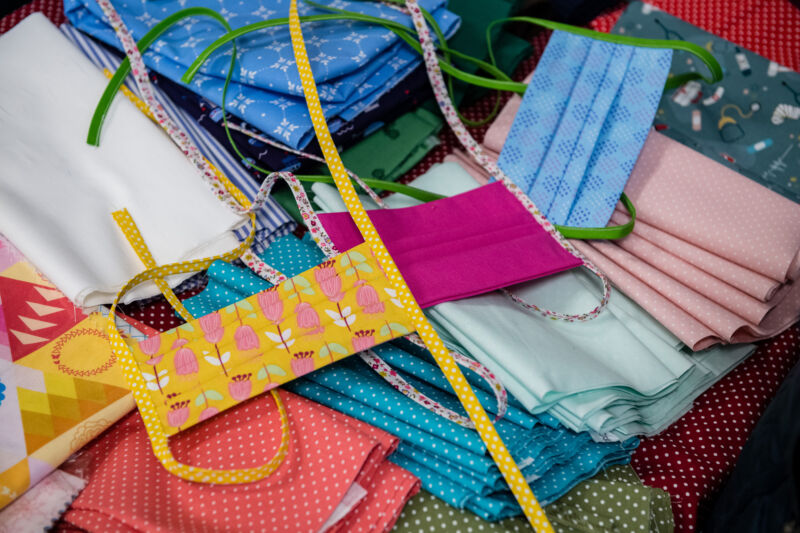double up —
Data has lots of caveats, but it’s not a bad idea to up your mask game.
Beth Mole
–

Enlarge / Self-sewn protective face masks in a fabric store on April 3, 2020, in Jena, Germany.
With the pandemic still raging and several dangerous variants looming, many experts have suggested doubling up on masks. Now, a new study by the Centers for Disease Control and Prevention doubles down on that strategy.
Adding a cloth mask over a surgical mask on a rubbery dummy head more than doubled particle blocking when the dummy simulated coughing—aka spewing particles capable of carrying coronavirus—the study found. Specifically, a surgical mask or a cloth mask alone blocked about 42 to 44 percent of particles, respectively, coming out of the coughing dummy. The combo of a cloth mask over a surgical mask blocked 92.5 percent of the risky particles.
Next, the CDC researchers gave the rubbery dummy head an equally disembodied friend, spaced about 2 meters (6 feet) away in a cozy, unventilated experimental chamber. When one of the heads quietly belched aerosol particles (source) while maskless, the researchers measured the dose of particles that the companion (receiver) took in during a 15-minute period. Wearing a surgical mask alone cut the receiver’s exposure to particles by just 7.5 percent, compared to wearing no mask. Wearing a double mask cut the exposure by 83 percent.
Then, the researchers flipped the scenario by trying out masks on the source and leaving the receiver maskless. A surgical mask alone on the source cut the maskless receiver’s exposure by about 41 percent. When the source wore a double mask, the maskless receiver’s exposure dropped to 82 percent.
When both the source and the receiver wore double masks, the receiver’s exposure dropped to 96 percent.

Enlarge / Masks tested, including A, unknotted medical procedure mask; B, double mask (cloth mask covering medical procedure mask); and C, knotted/tucked medical procedure mask.
Last, the researchers also tested out tucking and knotting a surgical mask on either the receiver or the source head. The tuck-and-knot reduces side gaps that let unfiltered-breath escape. This alone reduced the receiver’s exposure by 64.5 percent and 63 percent when it was used by the receiver or the source, respectively. When both heads had tucked-and-knotted masks, exposure dropped again by 96 percent.
Conclusions and cautions
“These laboratory-based experiments highlight the importance of good fit to maximize overall mask performance,” the researchers concluded. The agency’s researchers also noted the potential benefits of using other mask-tightening methods, such as using sheer nylon hosiery around your mask or a mask-fitter product to keep masks tighter around your face.
Let’s note some important caveats, though. The researchers emphasize that they were mainly looking at relative improvements in mask performance. The agency only tested one example of each mask type (surgical and cloth) and one type of combination—cloth over surgical mask. There is a plethora of mask options out there and ways to combine each one. It’s also unclear how the double-mask method used in the study would stack up to more stringent mask designs, such as the one outlined by the World Health Organization. That’s all to say that your specific results may vary. Last, another obvious limitation is that the researchers were using rubber heads, not the real ones.
“The findings of these simulations should neither be generalized to the effectiveness of all medical procedure [surgical] masks or cloth masks nor interpreted as being representative of the effectiveness of these masks when worn in real-world settings,” the researchers caution.
And, in the broader context of the threat of more infectious variants—it’s still unclear how much upping your mask game will help. So far, standard mask wearing and the other usual protective measures—physical distancing, avoiding crowds and poorly ventilated indoor spaces, and good hand hygiene—appear to remain effective against the variants. Still, as many experts have been saying recently, improving mask performance likely can’t hurt.

